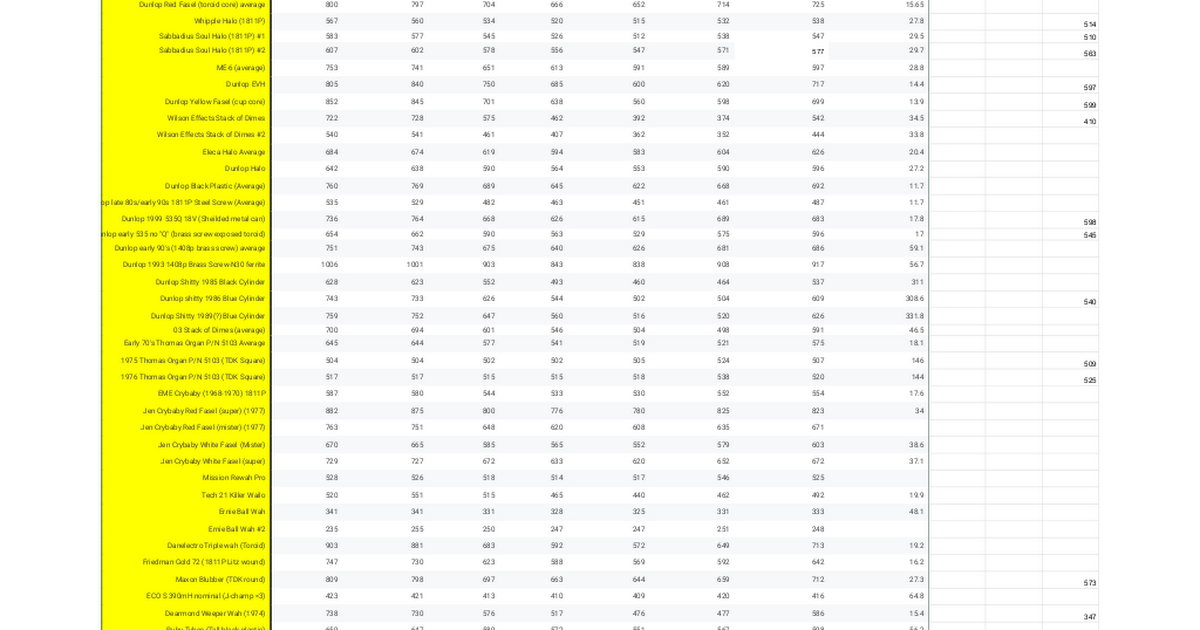Stickman393
Well-known member
*multiple edits made as of 11/25/24*
Alright folks, I've been collecting wah inductors as I've been working towards a few different expression pedal projects.
So, curiosity. How do all these compare? I might put together a little trial wah pedal and cycle a bunch of these one-by-one, but I'm not particularly inclined to believe that my ears can really do all that much to tell the difference. But...I do have a TC-1, and that'll give some objective idea of how each of these compare in this extremely limited realm of "hey, resistance/inductace info?"
*EDIT* I've got a spreadsheet set up now that contains Inductance, Q, and Reactance measurments with a new Hantek 1832C LCR meter.
Its not the worlds most fancy LCR meter, but it allows me to take measurements across different frequencies. I took measurements at 100Hz, 120hz, 400Hz, 1KHZ, 4KHz and 10KHZ, as well as each unit's base DC resistance. This meter measures at 648mV, and is extremely well calibrated an accurate stated frequency. The duty cycle is right about 50% for each.
I've also included measurments for each on my Honeytek LC meter for comparison. Important notes on that one: these readings are taken at 3.28Vac, 205.4Hz, 56.1% duty cycle.

 docs.google.com
docs.google.com
ALSO: I have a list of a whole bunch of crybabies that I have either A) purchased or B) been able to gather the relevant information from perusing for sale listings online
There are a few gaps. Post 2000, I don't have many examples. Ditto in the mid to late 80s.
Also, I've seen a few with serials that start with MMI: I'm fairly sure those fit in the gap between "AA-" and "AA", though they may be meant for export markets. Dunno.

 docs.google.com
docs.google.com
Initial Impressions: Well, balls.
My main takeaways? I'm still learning, so please post and correct if I say anything remarkably out of line here:
Notes:
*EDIT* now with CHARTS!






AND PHOTOS!



EDIT (11/23/24) Below are the first measurements I took. I recently picked up a new LCR meter, and the values shown below are not to be trusted. These were taken with my TC-1 and a cheapie LC meter from amazon. Use the link above for my spreadsheet.
Alright folks, I've been collecting wah inductors as I've been working towards a few different expression pedal projects.
So, curiosity. How do all these compare? I might put together a little trial wah pedal and cycle a bunch of these one-by-one, but I'm not particularly inclined to believe that my ears can really do all that much to tell the difference. But...I do have a TC-1, and that'll give some objective idea of how each of these compare in this extremely limited realm of "hey, resistance/inductace info?"
*EDIT* I've got a spreadsheet set up now that contains Inductance, Q, and Reactance measurments with a new Hantek 1832C LCR meter.
Its not the worlds most fancy LCR meter, but it allows me to take measurements across different frequencies. I took measurements at 100Hz, 120hz, 400Hz, 1KHZ, 4KHz and 10KHZ, as well as each unit's base DC resistance. This meter measures at 648mV, and is extremely well calibrated an accurate stated frequency. The duty cycle is right about 50% for each.
I've also included measurments for each on my Honeytek LC meter for comparison. Important notes on that one: these readings are taken at 3.28Vac, 205.4Hz, 56.1% duty cycle.
Wah Inductors
ALSO: I have a list of a whole bunch of crybabies that I have either A) purchased or B) been able to gather the relevant information from perusing for sale listings online
There are a few gaps. Post 2000, I don't have many examples. Ditto in the mid to late 80s.
Also, I've seen a few with serials that start with MMI: I'm fairly sure those fit in the gap between "AA-" and "AA", though they may be meant for export markets. Dunno.
Serial Numbers and Dates
Initial Impressions: Well, balls.
My main takeaways? I'm still learning, so please post and correct if I say anything remarkably out of line here:
- Many of these are remarkably similar.
- I imagine that higher reactance at higher frequencies will tend to attenuate higher frequencies in a wah pedal. I could be wrong.
- I also imagine that higher Q will result in a steeper drop-off around the resonant frequency, resulting in a more pronounced effect.
- Even within the same type of inductor, there is some variance that can be observed through this test.
Notes:
- Like capacitors, Inductors are not frequency-dependent, in that their inductance value in *Henries* does not change with frequency they are subjected to.
- Why am I measuring up to 30% drift in inductance across a 100Hz to a 10KHz band on something like the yellow fasel? Beats the hell out of me.
- Could be something about how building a "perfect" inductor is damned difficult.
- Maybe folks who are trying to re-create a vintage inductor are purposefully building "imperfect" inductors.
- Take the above for what it's worth: the musings of a man who has no idea what he's talking about.
- Transformers seemed to have the largest discrepancies in frequency input vs measured inductance.
- Seriously, on some of them when I cranked it to 10KHz my meter told me that I was measuring a capacitor. Weird.
- The two that seemed to have the most stable mH measurements are the "Whipple" and "Sabbadius" Halo inductors.
- Why am I measuring up to 30% drift in inductance across a 100Hz to a 10KHz band on something like the yellow fasel? Beats the hell out of me.
- Like capacitors, an Inductor's *Reactance* is frequency-dependent.
- This reactance is a measure of impedance, which measures how much the inductor impedes AC current.
- I included this measurement in my spreadsheet.
- There is a fair amount of variance between different inductors.
- My new meter also measures "Quality Factor" or "Q".
- Yeah, my shit is strut.
- A higher "Q" means that your wah will have a sharper roll-off across it's resonant frequency.
- Every single one of these experiences an increased "Q" when run up the frequency range, but some experience a slight drop off at the very top.
- Higher "Q" will be a bit more "dramatic" and "peak-y". Lower "Q" will be a more "mellow" and "smooth".
- This can also be adjusted via "R5" on the GCB-95 crybaby circuit board.
- Stock Value is 33K. Also the "Q" potentiometer on the Tear Jerker PCB.
- This resistor is in parallel with the inductor.
- Higher values will increase the "Q". A common mod is to replace the 33K with a 68K.
- Stock Value is 33K. Also the "Q" potentiometer on the Tear Jerker PCB.
- Importantly: all the transformers I tested (with the exception of the OmniFX cheapie) had *exceptionally* low Q. You'll probably have to make a major adjustment to the parallel resistance if you choose one of the "TM0" mini transformers as your inductor.
*EDIT* now with CHARTS!






AND PHOTOS!



EDIT (11/23/24) Below are the first measurements I took. I recently picked up a new LCR meter, and the values shown below are not to be trusted. These were taken with my TC-1 and a cheapie LC meter from amazon. Use the link above for my spreadsheet.
So take the following for what it's worth:
The numbers in parenthesis are from my Fluke 87+ and my honeytek LC meter.
Dunlop Yellow Fasel (cup core): 14.7 ohms/24.26mH (13.9 ohms/620mH)
Dunlop Red Fasel (toroid): 17.5 ohms/565.2mH (17 ohms/583mH)
Dunlop Crybaby GCB-95 (late 90's through early 00s) (Black plastic cylinder with white dot): 15.1 ohms/24.85 mH (14.6ohms/690mH)
Dunlop Crybaby GCB-95 (modern?) (black plastic cylinder with white paint dot): 17.8ohms/599.4mH (17.4 ohms/645mH)
Dunlop Hendrix crybaby (late 90s though early 00s) (black plastic cylinder with green paint dot): 14.1 ohms/14.03mH (13. 7ohms/564mH)
Dunlop Crybaby GCB-95 80's (Mexico): 12 ohms/76.78mH (11.8ohms/343mH)
Mammoth/SBP ME-6: 30.7 ohms/730.3mH (29.4 ohms/622mH)
Ruby Tubes tall plastic: 57.7 ohms/592mH (56.2 ohms/579mH)
Whipple Halo: 28.8 ohms/580.7mH (27.8ohms/522uH)
Sabbadius Soul Halo: 30.3 ohms/ 597.8mH (29.5 ohms/510mH)
Dunlop Crybaby 535 (Brass screw, exposed toroid): 17.8 ohms/582mH
Dunlop Crybaby 535q 18Vdc (metal can. shielded): 18.3 ohms/593.3mH
Dunlop EVH inductor: 14.8 ohms/15.83mH (14.4 ohms/666mH)**************************** fuck yea
Transformers!
TM-011-R:
Primary: 124.8ohms/2181mH
P Center tap: 62.3ohms/255.7
Secondary: 47.3ohms/357.1MH
S center tap: out of range
Tm018-R:
Primary: out of range (shows up as diodes)
P center tap: 271.4ohms/6059mH
(Secondary identical)
TM022-R
Primary: out of range (shows up as diodes)
P center tap: 276.8 ohms/5335mH
Secondary: 147.3ohms/3359mH
S center tap: 75.5/504.5mH
Hammond 142B:
Primary: out of range (diodes)
P Center tap: 389.8ohms/8415mH
Secondary: 215.4ohms/6448mH
S Center tap: 104.2ohms/885.8mH
Last edited:

